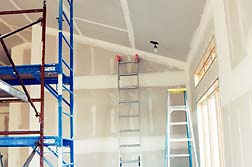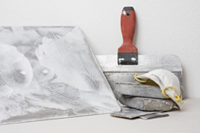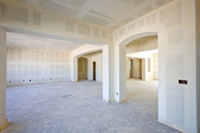LAWSUITS NEWS & LEGAL INFORMATION
Defective Chinese Drywall Problems
Read our Chinese Drywall Problem FAQ
uilders and environmental consultants began investigating Chinese drywall after reports that the potentially toxic drywall caused unpleasant (rotten egg) odors. According to the Florida Department of Health and US Consumer Product Safety Commission, as of July 30, 2009, twenty-three states have reported 681 cases of health problems and/or metal corrosion associated with Chinese Drywall. Those states hardest hit are Florida, Louisiana, Alabama, Georgia and Virginia, but complaints from Arizona and California are also increasing.
 Anyone who owns a house built between 2002 and 2007 could have a problem with contaminated drywall. Americas Watchdog Consumer center officials believe the toxic drywall entered the country at the ports of Long Beach, Oakland and Seattle/Tacoma starting in 2001 and that homebuilders and contractors began using it a year or so later.
Anyone who owns a house built between 2002 and 2007 could have a problem with contaminated drywall. Americas Watchdog Consumer center officials believe the toxic drywall entered the country at the ports of Long Beach, Oakland and Seattle/Tacoma starting in 2001 and that homebuilders and contractors began using it a year or so later.
Consumers who bought homes during the housing boom are also worried that Chinese drywall problems can lead to electrical problems, thus making it difficult to sell their homes. Drywall, also known as wallboard or plasterboard, is typically made from the mineral gypsum in the US, but a shortage led suppliers to import drywall from gypsum mines in China.
Homeowners are concerned over the potential for property damage and health problems resulting from drywall from China that reportedly leaks corrosive chemicals. Reports include copper tubing turning black, the failure of air conditioning coils exposed to the drywall, smells of sulfur and illness (possibly from breathing airborne sulfuric compounds), including respiratory problems, nosebleeds and headaches.
Currently, The Centers for Disease Control and Prevention (CDC) is working with the Consumer Product Safety Commission (CPSC), the Agency for Toxic Substances and Disease Registry (ATSDR), the U.S. Environmental Protection Agency (USEPA), and state health departments to learn about possible health problems from living in a home with imported drywall and how to advise the public to protect their health. Furthermore, CDC is working with federal agencies responsible for indoor and outdoor air testing to ensure that the results can help answer health questions.
Drywall Building Inspectors
One home inspector suggests that no home should be sold in the state of Florida (the epicenter of Chinese drywall complaints) that was built after 2000 without being tested for contaminated drywall. According to Florida's Intuitive Environmental Solutions, an environmental consulting and inspection firm specializing in indoor air quality and mold contamination issues, the gypsum material used in some of the imported drywall was initially used as filter media in the smokestacks of coal-fired power plants to reduce air pollution. The gypsum material was used to remove contaminants from the high-sulfur-content coal.
The firm suspects that some of the drywall imported from China in 2004 and 2005 to states such as Florida, Louisiana and Virginia was made with waste products taken from scrubbers on coal-fired power plants. Those materials can subsequently off-gas into the atmosphere, and when those gases combine with moisture on air conditioning coils they create sulfuric acid. This in turn, appears to be dissolving solder joints and copper tubing, creating leaks, blackening the coils and causing air conditioning systems to fail. In addition, copper wiring, piping and copper associated with refrigerators inside some homes are corroding along with mirrors, jewelry, faucets and drains. Some homeowners have reported fixtures—such as towel racks—falling off their walls.
Chinese Drywall Lawsuits
As of March 10, 2009 six class-action lawsuits had been filed in Florida on behalf of more than 2,000 homeowners in that state who claim their homes are eroding because of contaminated drywall. Miami-based Lennar Corp., one of the largest homebuilders in the United States and California, has been named as a defendant. Lennar Corp. has subsequently filed suit against numerous U.S. drywall manufacturers, which reportedly ordered drywall made in China and then shipped it into the US.
In June 2009, the U.S. Judicial Panel on Multidistrict Litigation (MDL) consolidated many lawsuits regarding Chinese-made drywall installed in U.S. homes. According to masstortdefense.com, the motion for consolidation encompassed ten actions, four of which were in the Southern District of Florida, three actions in the Middle District of Florida and one action each in the Northern District of Florida, Eastern District of Louisiana, and Southern District of Ohio. The MDL panel said it knew of 67 related lawsuits that were pending in federal courts around the country.
The lawsuits allege sulfur compound levels in the drywall are too high, causing issues with air conditioning systems, electrical appliances, internal wiring and other electrical systems in homes. Plaintiffs also claim the contaminated drywall produces a rotten egg-like stench and causes a variety of respiratory and other health problems for those who live in the affected homes. The lawsuits filed so far have named Chinese-based manufacturers, as well as importers, developers and builders, contractors, suppliers and others. Companies facing suits include Knauf Gips KG, Knauf Plasterboard Tianjin Co., Taishan Gypsum Co., L&W Supply Corp. and USG Corp. Lennar Corp., a major home builder, has brought in more than 20 manufacturers, suppliers and installers.
Lawsuits in other states, including California, are currently pending.
Last updated on
FREE CHINESE DRYWALL PROBLEM LAWSUIT EVALUATION
Send your Chinese Drywall Problem claim to a lawyer who will review your claim at NO COST or obligation.
GET LEGAL HELP NOW
GET LEGAL HELP NOW
Chinese Drywall Problems
The Homeowners Consumer Center in Washington, D.C says Chinese drywall has allegedly been used in residential construction in all 50 states, but mainly in Florida, Louisiana and Virginia, between 200,000 and 300,000 residences could be impacted nationwide. Anyone who owns a house built between 2002 and 2007 could have a problem with contaminated drywall. Americas Watchdog Consumer center officials believe the toxic drywall entered the country at the ports of Long Beach, Oakland and Seattle/Tacoma starting in 2001 and that homebuilders and contractors began using it a year or so later.
Anyone who owns a house built between 2002 and 2007 could have a problem with contaminated drywall. Americas Watchdog Consumer center officials believe the toxic drywall entered the country at the ports of Long Beach, Oakland and Seattle/Tacoma starting in 2001 and that homebuilders and contractors began using it a year or so later.
Consumers who bought homes during the housing boom are also worried that Chinese drywall problems can lead to electrical problems, thus making it difficult to sell their homes. Drywall, also known as wallboard or plasterboard, is typically made from the mineral gypsum in the US, but a shortage led suppliers to import drywall from gypsum mines in China.
Homeowners are concerned over the potential for property damage and health problems resulting from drywall from China that reportedly leaks corrosive chemicals. Reports include copper tubing turning black, the failure of air conditioning coils exposed to the drywall, smells of sulfur and illness (possibly from breathing airborne sulfuric compounds), including respiratory problems, nosebleeds and headaches.
Currently, The Centers for Disease Control and Prevention (CDC) is working with the Consumer Product Safety Commission (CPSC), the Agency for Toxic Substances and Disease Registry (ATSDR), the U.S. Environmental Protection Agency (USEPA), and state health departments to learn about possible health problems from living in a home with imported drywall and how to advise the public to protect their health. Furthermore, CDC is working with federal agencies responsible for indoor and outdoor air testing to ensure that the results can help answer health questions.
Drywall Building Inspectors
One home inspector suggests that no home should be sold in the state of Florida (the epicenter of Chinese drywall complaints) that was built after 2000 without being tested for contaminated drywall. According to Florida's Intuitive Environmental Solutions, an environmental consulting and inspection firm specializing in indoor air quality and mold contamination issues, the gypsum material used in some of the imported drywall was initially used as filter media in the smokestacks of coal-fired power plants to reduce air pollution. The gypsum material was used to remove contaminants from the high-sulfur-content coal.
The firm suspects that some of the drywall imported from China in 2004 and 2005 to states such as Florida, Louisiana and Virginia was made with waste products taken from scrubbers on coal-fired power plants. Those materials can subsequently off-gas into the atmosphere, and when those gases combine with moisture on air conditioning coils they create sulfuric acid. This in turn, appears to be dissolving solder joints and copper tubing, creating leaks, blackening the coils and causing air conditioning systems to fail. In addition, copper wiring, piping and copper associated with refrigerators inside some homes are corroding along with mirrors, jewelry, faucets and drains. Some homeowners have reported fixtures—such as towel racks—falling off their walls.
Chinese Drywall Lawsuits
As of March 10, 2009 six class-action lawsuits had been filed in Florida on behalf of more than 2,000 homeowners in that state who claim their homes are eroding because of contaminated drywall. Miami-based Lennar Corp., one of the largest homebuilders in the United States and California, has been named as a defendant. Lennar Corp. has subsequently filed suit against numerous U.S. drywall manufacturers, which reportedly ordered drywall made in China and then shipped it into the US.
In June 2009, the U.S. Judicial Panel on Multidistrict Litigation (MDL) consolidated many lawsuits regarding Chinese-made drywall installed in U.S. homes. According to masstortdefense.com, the motion for consolidation encompassed ten actions, four of which were in the Southern District of Florida, three actions in the Middle District of Florida and one action each in the Northern District of Florida, Eastern District of Louisiana, and Southern District of Ohio. The MDL panel said it knew of 67 related lawsuits that were pending in federal courts around the country.
The lawsuits allege sulfur compound levels in the drywall are too high, causing issues with air conditioning systems, electrical appliances, internal wiring and other electrical systems in homes. Plaintiffs also claim the contaminated drywall produces a rotten egg-like stench and causes a variety of respiratory and other health problems for those who live in the affected homes. The lawsuits filed so far have named Chinese-based manufacturers, as well as importers, developers and builders, contractors, suppliers and others. Companies facing suits include Knauf Gips KG, Knauf Plasterboard Tianjin Co., Taishan Gypsum Co., L&W Supply Corp. and USG Corp. Lennar Corp., a major home builder, has brought in more than 20 manufacturers, suppliers and installers.
Lawsuits in other states, including California, are currently pending.
Chinese Drywall Legal Help
If you or a loved one has suffered damages in this case, please click the link below and your complaint will be sent to a lawyer who may evaluate your claim at no cost or obligation.Last updated on
CHINESE DRYWALL PROBLEM LEGAL ARTICLES AND INTERVIEWS
Construction Firm Begins Fixing Florida Homes Containing Chinese Drywall

Florida Resident Sickened by Chinese Drywall Forced from Home

CDC: No Link between Chinese Drywall and 11 US Deaths


March 8, 2011
Fort Lauderdale, Florida-based construction company Moss & Associates was chosen recently to fix homes that have been affected by Chinese drywall, the Miami Herald reports. READ MORE
Florida Resident Sickened by Chinese Drywall Forced from Home

February 20, 2011
Her name is Eleanor Aguilar and Chinese drywall chased her out of her own home. Her townhouse in Lauderhill, Florida, was built with defective China drywall from Knauf Plasterboard Tianjin. The defective drywall compromised her health as well as her appliances—and now her home will take three months to remediate. READ MORE
CDC: No Link between Chinese Drywall and 11 US Deaths

February 8, 2011
The Centers for Disease Control and Prevention recently said that it did not find a link between Chinese drywall and the deaths of 11 people across the country living with the defective product, The Associated Press reports. READ MORE

READER COMMENTS
Nevada
on
New York
on
Florida
on
Pennsylvania
on